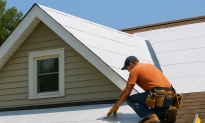 How to Build a Cool Roof for Your Home in 2025
How to Build a Cool Roof for Your Home in 2025
As energy efficiency becomes a top priority for homeowners, cool roofs are emerging as a simple yet powerful upgrade. Designed to reflect more sunlight and absorb less heat, a cool roof can lower energy bills, improve indoor comfort, and extend roof life — especially important in hot or sunny regions.
This guide covers everything you need to know about building a cool roof for a single-family household in 2025, including advantages, challenges, retrofit options, and price estimates.
What is a Cool Roof?
A cool roof is made of materials or coatings that reflect sunlight (solar reflectance) and radiate absorbed heat away (thermal emittance) much better than a standard roof.
Key Features:
-
High solar reflectance (bright or reflective colors)
-
High thermal emittance (quickly releases heat)
-
Lowers surface temperatures by up to 50°F (10–30°C) compared to dark roofs
Pros of Building a Cool Roof
| Advantage | Details |
|---|---|
| Lower Cooling Costs | Can reduce air conditioning needs by 10–30% |
| Environmental Benefits | Reduces urban heat islands and lowers carbon footprint |
| Longer Roof Life | Reduced thermal stress extends roof material lifespan |
| Potential Rebates | Many utilities offer incentives for cool roof installs |
Cons of Building a Cool Roof
| Disadvantage | Details |
|---|---|
| Higher Heating Costs | In colder climates, winter heating needs could increase slightly |
| Color Choices Limited | Reflective roofing often means lighter colors (though new tech allows more variety now) |
| Upfront Cost | Some materials and coatings are slightly more expensive upfront |
Conditions Required for a Cool Roof Installation
-
Roof Structure: Must be in good condition (no major damage or sagging)
-
Climate: Best suited for hot, sunny regions (Southwest U.S., Florida, California, etc.)
-
Roof Slope:
-
Low-slope (flat): Easily accommodates coatings and membrane-based cool systems
-
Steep-slope (pitched): Can use cool-colored shingles, tiles, or metal roofs
-
-
Local Building Codes: Some cities (like Los Angeles) require cool roofs on new or re-roofed homes
How to Build or Retrofit a Cool Roof
New Construction or Full Re-Roofing
Choose cool roofing materials from the start:
-
Cool asphalt shingles
-
Reflective metal roofing
-
Cool roof tiles (clay or concrete with coatings)
-
Single-ply membranes (TPO, PVC) for flat roofs
Pro Tip: Look for products with the ENERGY STAR® or Cool Roof Rating Council (CRRC) label.
Retrofitting an Existing Roof
If you have a good-condition roof, you can add a reflective coating instead of a full replacement:
-
Cool Roof Coatings (elastomeric or acrylic)
-
Applied like thick paint
-
Reflects sunlight and seals small cracks
-
Can extend roof life by 5–10 years
-
Pro Tip: Always clean and prep the surface properly before applying coating for best adhesion.
Price Estimates for Building a Cool Roof (2025)
| Component | Price Range (USD) |
|---|---|
| Cool Asphalt Shingles | $4.00 – $6.50 per sq. ft. installed |
| Reflective Metal Roofing | $7.50 – $13.00 per sq. ft. installed |
| Single-Ply Membrane (Flat Roof) | $5.00 – $8.00 per sq. ft. installed |
| Cool Roof Coating (Retrofit) | $1.50 – $4.00 per sq. ft. applied |
| Total Roof Replacement (Avg. Home, 2,000 sq. ft.) | $10,000 – $25,000 depending on material |
Savings Potential:
Homeowners typically save 10%–30% annually on cooling bills, depending on climate and house insulation quality.
Bonus: Incentives and Rebates
Many states, cities, and utilities in 2025 offer rebates for installing cool roofs. Example programs include:
-
California Title 24 building codes
-
Florida PACE programs
-
Federal Energy-Efficient Home Improvement Credit (up to 30% of costs)
Always check dsireusa.org for up-to-date incentives in your area!
